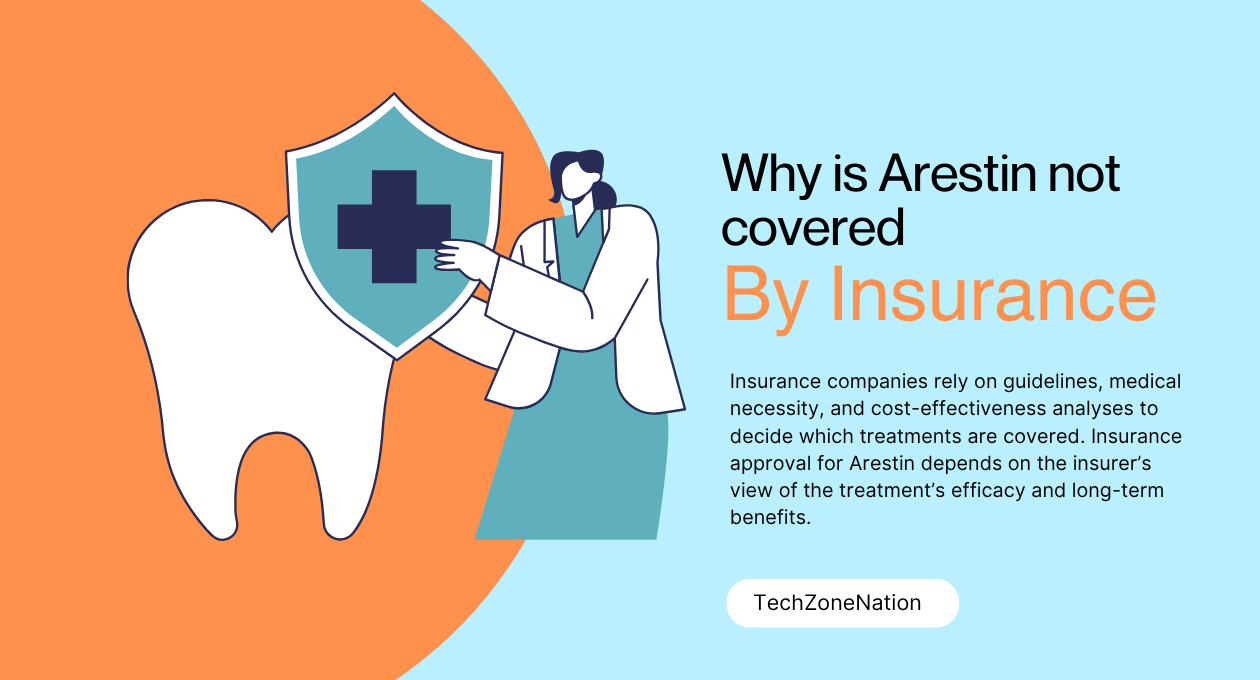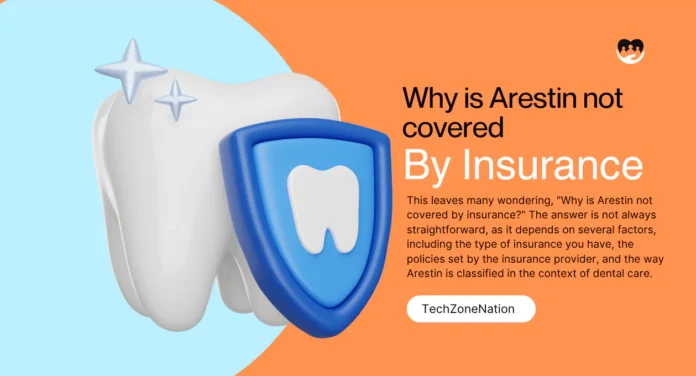If you’ve been diagnosed with gum disease, your dentist might suggest incorporating Arestin into your treatment strategy. Arestin treatment is an effective way to combat gum disease, but many patients are surprised to find that Arestin is often not covered by insurance. This leaves many wondering, “Why is Arestin not covered by insurance?” The answer is not always straightforward, as it depends on several factors, including the type of insurance you have, the policies set by the insurance provider, and the way Arestin is classified in the context of dental care.
Insurance companies often view Arestin as an optional or cosmetic treatment rather than a medically necessary one, which can lead to coverage denials. This can be frustrating, especially when Arestin treatment and insurance coverage could significantly improve oral health. Understanding the reasons behind these exclusions can help you navigate your options.
Introduction to Arestin and Its Use in Dental Care
Arestin is a topical antibiotic gel that is often prescribed for the treatment of periodontal disease. It is directly applied to infected areas of the gums to target bacteria, helping to reduce infection and inflammation. This treatment is typically used after scaling and root planing, a common procedure for deep cleaning teeth. Arestin’s active ingredient, minocycline, helps to eliminate harmful bacteria, promoting better gum health and preventing further damage.
This treatment is frequently advised for individuals dealing with moderate to advanced periodontal disease. If left untreated, gum disease can result in tooth loss and may contribute to other significant health complications. By using Arestin, dentists aim to help their patients avoid surgery and reduce the need for more aggressive treatments. However, despite its effectiveness, Arestin is not always covered under standard dental insurance plans. This leads to confusion and frustration for patients who need the treatment but cannot afford it out-of-pocket.
What is Arestin and Why Is It Crucial for Periodontal Health?
Arestin plays a crucial role in periodontal care. It is an FDA-approved treatment used to treat gum disease, particularly for cases where the infection does not respond to traditional methods like cleaning or oral hygiene improvements. By placing the antibiotic directly into pockets of infection in the gums, Arestin application covered by dental insurance ensures a long-lasting solution to gum disease.
Periodontal disease is an infection caused by bacteria that targets the tissues supporting your teeth, such as the gums and bone. Without treatment, it can lead to tooth loss. Arestin treatment helps reduce the bacteria, and over time, it can help heal the gums, restore tissue health, and prevent further complications. Its targeted delivery system allows for continuous release of the antibiotic, making it effective for extended periods. This approach helps patients manage their gum disease more effectively than with just routine cleanings.
Does Insurance Cover Arestin? An Overview
When it comes to Arestin and insurance coverage, the answer is often unclear. Many patients ask, “Does insurance cover Arestin?” or “Does my insurance cover Arestin?” Unfortunately, not all dental insurance plans include this treatment. Dental insurance coverage for Arestin is inconsistent and often depends on the insurance provider and the specific plan. The treatment is sometimes seen as a cosmetic or non-essential treatment by insurance companies, making it harder for patients to get coverage.
In general, dental insurance plans for Arestin may cover the procedure if it’s seen as part of a broader treatment plan for gum disease. However, there are exclusions in most dental insurance exclusions for Arestin. Many insurers argue that Arestin is an optional treatment, especially since it is used after scaling and root planing, which they may already cover. This distinction can make it hard for patients to get the insurance approval for periodontal disease treatments like Arestin.
Common Reasons Why Arestin is Not Covered by Insurance
One of the main reasons Arestin isn’t covered is that it is often classified as a cosmetic or optional treatment. Insurance companies usually cover treatments that are considered medically necessary. Arestin treatment covered by dental insurance can be difficult to obtain if the insurance company deems it as a supplemental treatment, not a primary one. This classification can lead to insurance claims for Arestin treatment being denied.
Another reason is that Arestin is not viewed as a proven long-term solution for periodontal disease. Insurers often favor treatments with documented, long-term success. Arestin prescription coverage is rare because some insurance companies question the efficacy of the treatment in preventing future gum disease. The cost of Arestin treatment is also a factor—since it involves specialized care, it’s often more expensive than traditional methods, and insurance companies may not see it as a cost-effective option.
How Insurance Affects the Treatment of Periodontal Disease
Insurance plays an important role in helping patients access necessary periodontal disease treatments. Many insurance policies for periodontal disease treatment cover routine cleanings and basic treatments but do not include specialized treatments like Arestin. The reason for this is often tied to cost—insurance companies focus on the most common and widely accepted treatments for gum disease, which they believe are more cost-effective.

For patients needing advanced care, like Arestin, the process can become more complicated. Insurers might not cover Arestin because they prefer more traditional treatments like scaling and root planing. However, these traditional treatments may not always be as effective for patients with severe gum disease. Thus, the insurance system doesn’t always align with the best treatment options available to patients.
Are There Alternatives to Arestin That Insurance May Cover?
Yes, there are alternatives to Arestin that are typically covered by insurance. Treatments like scaling and root planing (deep cleaning) are often included in dental insurance plans for gum disease. These methods are usually considered less expensive than Arestin and are seen as sufficient for less severe cases of periodontal disease.
While these alternatives may not be as effective for all patients, they are often the first line of defense in treating gum disease. If Arestin treatment is not covered, patients may need to consider these more basic treatments. However, if the disease is advanced, Arestin remains the preferred choice, and patients may need to explore ways to get it covered through other means, such as medical insurance for Arestin treatment.
Can You Get Arestin Without Insurance? Exploring Out-of-Pocket Costs
For many patients, the biggest question is how much Arestin costs without insurance. The cost of Arestin with insurance can vary, but without insurance, the cost can be quite high. On average, the price for Arestin ranges from $300 to $500 per treatment. This can add up if multiple areas of the mouth need to be treated, making it unaffordable for some individuals.
If you are looking to get Arestin without insurance, it is important to talk to your dentist about payment options. Many dental offices offer payment plans or financing options, which can help make the cost more manageable. Some offices also participate in discount programs, where you can get affordable Arestin treatment with insurance or at a reduced rate without it.
How to Appeal Your Insurance’s Decision on Arestin Coverage
If your insurance company has denied coverage for Arestin, don’t give up hope. First, contact your insurance provider to understand why Arestin was not covered. If the reason seems unclear or unjustified, you can file an appeal.
You will need to gather supporting documentation from your dentist, including evidence of the severity of your gum disease and why Arestin is the best option for your treatment. Your dentist may also need to provide additional information on the long-term benefits of Arestin treatment. After submitting your appeal, follow up with your insurance company regularly until you receive an answer.
How Insurance Companies Decide What Treatments to Cover
Insurance companies rely on guidelines, medical necessity, and cost-effectiveness analyses to decide which treatments are covered. Insurance approval for Arestin depends on the insurer’s view of the treatment’s efficacy and long-term benefits. If they believe that a less expensive option, such as scaling and root planing, can achieve the same results, they may deny coverage for Arestin.

These decisions are often influenced by both clinical guidelines and cost-saving measures. For instance, if a treatment is perceived as not providing enough added value over standard methods, it may be excluded from coverage. In such cases, appealing the decision and providing additional evidence of the treatment’s effectiveness can help in securing approval.
Exploring Discount Programs and Payment Plans for Arestin
In cases where Arestin is not covered by insurance, there are often other options available. Many dental offices offer discount programs that provide patients with reduced rates for treatments like Arestin. These programs can help make the treatment more affordable, especially if the patient is uninsured or has limited insurance coverage.
Additionally, payment plans are another option that can help spread out the cost of Arestin over time. Some offices work with third-party financing companies that allow patients to pay for treatments in installments. If you find yourself struggling to afford Arestin treatment, it’s worth asking your dentist about these options to make the procedure more manageable.
The Future of Arestin Coverage by Insurance: Is Change Likely?
As periodontal health awareness grows, there is hope that insurance coverage for treatments like Arestin will improve. More research is needed to prove the long-term cost-effectiveness of Arestin in preventing advanced gum disease and tooth loss. If future studies show significant benefits, insurance companies may start to revise their policies to include Arestin coverage.
Additionally, patient advocacy groups are working to raise awareness about the importance of gum disease treatment and how treatments like Arestin can help reduce future healthcare costs. With continued pressure and evidence of the treatment’s benefits, we may see changes in how insurance for periodontal disease treatment is handled.
FAQs
Does insurance cover Arestin?
Insurance coverage for Arestin depends on the provider and plan. Many dental insurance plans do not cover it as they view it as an optional treatment.
How much does Arestin cost with insurance?
The cost of Arestin with insurance varies depending on the plan, but it can still involve significant out-of-pocket costs for co-pays or deductibles.
What dental plans cover Arestin?
Coverage for Arestin varies by dental insurance plan. Some may cover it under certain conditions, especially if it’s deemed medically necessary for treating periodontal disease.
Can I get Arestin without insurance?
Yes, you can get Arestin without insurance, but the cost is usually between $300 and $500 per treatment. Many dental offices offer financing or payment plans to help manage the cost.
How to get Arestin approved by insurance?
To get Arestin approved, you may need to file an appeal with your insurance company, providing evidence from your dentist on why it’s necessary for your periodontal health.
Are there alternatives to Arestin that insurance covers?
Yes, alternatives like scaling and root planing (deep cleaning) are often covered by insurance and may be used to treat less severe cases of gum disease.
Why is Arestin not covered by insurance?
Arestin is sometimes considered an optional or cosmetic treatment, which is why many insurance companies do not cover it, despite its effectiveness in treating periodontal disease.
Conclusion: Understanding Your Options When Arestin Isn’t Covered
While Arestin is a highly effective treatment for periodontal disease, it’s not always covered by insurance. Understanding why Arestin may not be covered, the alternatives available, and how to appeal an insurance decision can help you make an informed choice about your treatment. If Arestin cost with insurance is a concern, it’s important to explore options like payment plans, discount programs, or financing to manage the expense.
Ultimately, the key to managing Arestin treatment costs lies in knowing your rights and options. Whether through medical insurance coverage for Arestin or out-of-pocket payment plans, there are ways to access this vital treatment even without full insurance coverage. Don’t hesitate to speak with your dental provider about all the available options to ensure you can get the care you need.



